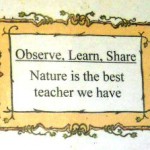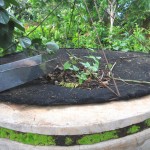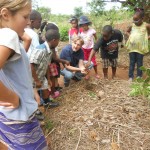 One of the main principles in Permaculture is to ‘Observe, Learn, and Share’. Our observations are based on the interactions within natural systems, our learning is based on application of these systems to our own lives, and our sharing of these solutions is inherent within Permaculture’s second ethic: ‘Care for People’.
One of the main principles in Permaculture is to ‘Observe, Learn, and Share’. Our observations are based on the interactions within natural systems, our learning is based on application of these systems to our own lives, and our sharing of these solutions is inherent within Permaculture’s second ethic: ‘Care for People’.
We were just out ‘observing and learning’ from our garden this morning and we came across a great example of nature at work (see picture). It is a picture of the top of one of our rainwater catchment tanks. This simple brick-and-cement tank holds approximately 3000 liters and collects water from the front half of our roof. When we actually did the water runoff calculations (1 meter squared x 1 mm of rain = 1 liter of water) we realized that we could fill 12-15 tanks this size during one of our rainy seasons where we live in Malawi. This, in essence, means that we could probably meet all of our dry season water needs (for bathing, washing, building, and drinking (if boiled and filtered)), just from half of our roof if we had built enough tanks.

We covered the top of this tank with a mesh shade-cloth to act as a filter for large leaves and other organic matter that might fall into the tank. In this picture you can see that as the organic matter has built up on the mesh, it has begun to break down into soil and has even collected seeds that have germinated. These seeds are a type of local lima bean known as ‘chimbamba’ or ‘kamumpanda’. These seeds have dropped off the vines from last year’s crop and are self-seeding all over the yard. I think that it has been 4-5 years since we have actually gone out and ‘planted’ beans, nature now does the majority of the work for us. These beans produce continually throughout the dry season without irrigation, offer a delicious source of protein, fix nitrogen in the soil, and even produce edible leaves that can be used as a vegetable. As we observed these beans growing from the top of our water tank–a process that occurred without any human interference–we wondered why it has become so difficult in our modern world for people to see the advantage of using resources to their fullest potential. In this era of ‘monocropped’ thinking, we seem to have convinced ourselves that diversity is a ‘bad word’ and that nature can no longer function without artificial intervention. The powers-that-be have done a wonderful job of telling us that plants can no longer grow without the application of synthetic fertilizers, herbicides, and pesticides. This has become the driving force behind the genetic engineering of Monsanto’s ‘Roundup Ready’ crops, as well as the demand for fossil fuels to power our ‘industrialized agriculture’ and our over-reliance on only a handful of staple crops to try to feed an ever-growing population (Ironically, all of these things have purportedly been done to ‘alleviate’ world hunger, when in fact these practices have been making it harder to feed ourselves).

Never Ending Food has become a study in contrasts: We are feasting on daily abundance while others are starving because they try to get all of their food in April; we have access to incredible nutritional diversity while 48% of Malawi’s children are ‘nutritionally stunted’; we minimize labor by utilizing seasonal harvests while others are putting a great deal of energy into high-input one-season systems with resulting low-yields…and the list goes on. Thousands of people have come to Never Ending Food over the years to learn about sustainable designs for living, but not all of these people have returned home to implement these ideas in their own lives. Many of Permaculture’s designs are based on practical, low-input, and common-sense approaches, yet throughout the world many Permaculture practitioners are finding that it is not the designs themselves that pose a stumbling block to implementation but rather it is human behavior change. If we start teaching our children that the world has everything it needs to feed itself, perhaps we will usher in a future of food security and sustainability the likes of which we can now only dream!
